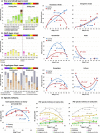Vegetation on mesic loamy and sandy soils along a 1700-km maritime Eurasia Arctic Transect
- PMID: 31130818
- PMCID: PMC6519894
- DOI: 10.1111/avsc.12401
Vegetation on mesic loamy and sandy soils along a 1700-km maritime Eurasia Arctic Transect
Abstract
Questions: How do plant communities on zonal loamy vs. sandy soils vary across the full maritime Arctic bioclimate gradient? How are plant communities of these areas related to existing vegetation units of the European Vegetation Classification? What are the main environmental factors controlling transitions of vegetation along the bioclimate gradient?
Location: 1700-km Eurasia Arctic Transect (EAT), Yamal Peninsula and Franz Josef Land (FJL), Russia.
Methods: The Braun-Blanquet approach was used to sample mesic loamy and sandy plots on 14 total study sites at six locations, one in each of the five Arctic bioclimate subzones and the forest-tundra transition. Trends in soil factors, cover of plant growth forms (PGFs) and species diversity were examined along the summer warmth index (SWI) gradient and on loamy and sandy soils. Classification and ordination were used to group the plots and to test relationships between vegetation and environmental factors.
Results: Clear, mostly non-linear, trends occurred for soil factors, vegetation structure and species diversity along the climate gradient. Cluster analysis revealed seven groups with clear relationships to subzone and soil texture. Clusters at the ends of the bioclimate gradient (forest-tundra and polar desert) had many highly diagnostic taxa, whereas clusters from the Yamal Peninsula had only a few. Axis 1 of a DCA was strongly correlated with latitude and summer warmth; Axis 2 was strongly correlated with soil moisture, percentage sand and landscape age.
Conclusions: Summer temperature and soil texture have clear effects on tundra canopy structure and species composition, with consequences for ecosystem properties. Each layer of the plant canopy has a distinct region of peak abundance along the bioclimate gradient. The major vegetation types are weakly aligned with described classes of the European Vegetation Checklist, indicating a continuous floristic gradient rather than distinct subzone regions. The study provides ground-based vegetation data for satellite-based interpretations of the western maritime Eurasian Arctic, and the first vegetation data from Hayes Island, Franz Josef Land, which is strongly separated geographically and floristically from the rest of the gradient and most susceptible to on-going climate change.
Keywords: Arctic; Braun‐Blanquet classification; DCA ordination; Normalized Difference Vegetation Index; above‐ground biomass ordination; bioclimate subzones; plant growth forms; remote sensing; soil texture; summer warmth index; tundra biome.
Figures





References
-
- Alexandrova, V. D. (1980). The arctic and antarctic: Their division into geobotanical areas. Cambridge, UK: Cambridge University Press.
-
- AMAP . (2010). Assessment 2007: Oil and gas activities in the Arctic — effects and potential effects. (Vol. 1 & 2; pp. 423–277). Oslo, Norway: Arctic Monitoring and Assessment Programme (AMAP) Retrieved from https://www.amap.no/documents/doc/assessment-2007-oil-and-gas-activities...
-
- Belland, R. (2012). Arctic moss database. Retrieved 20 May 2016, cited in Raynolds, M. K., Breen, A. L., Walker, D. A., Elven, R., Belland, R., Konstantinova, N., … Hennekens, S. (2013) The Pan‐Arctic Species List (PASL). Arctic Vegetation Archive Workshop, Krakow, Poland, 14‐16 April 2013, CAFF Proceedings Series Report No. 10 (pp. 92–95).
-
- Bhatt, U. S. , Walker, D. A. , Raynolds, M. K. , Bieniek, P. A. , Epstein, H. E. , Comiso, J. C. , … Polyakov, I. (2013). Recent declines in warming and vegetation greening trends over pan‐Arctic tundra. Remote Sensing, 5, 4229–4254. 10.3390/rs5094229 - DOI
-
- Bhatt, U. S. , Walker, D. A. , Raynolds, M. K. , Comiso, J. C. , Epstein, H. E. , Jia, G. , … Webber, P. J. (2010). Circumpolar Arctic tundra vegetation change is linked to sea ice decline. Earth Interactions, 14, 1–20. 10.1175/2010EI315.1 - DOI
LinkOut - more resources
Full Text Sources
